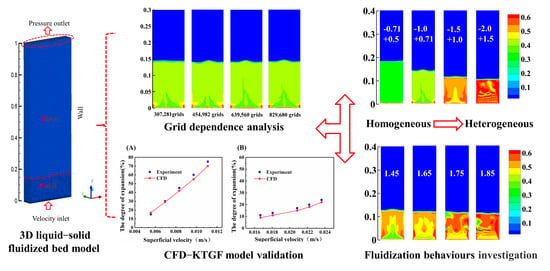CFD Modeling and Simulation of the Hydrodynamics Characteristics of Coarse Coal Particles in a 3D Liquid-Solid Fluidized Bed
Abstract
1. Introduction
2. CFD Mathematical Model Development
2.1. CFD-KTGF Model
2.2. Turbulent Model
2.3. Interphase Force Models
2.3.1. Gidaspow Drag Force Model
2.3.2. Moraga Lift Force Model
3. Simulation Details
4. Results and Discussion
4.1. Grid Dependence Analysis
4.2. Model Validation
4.3. Model Application
4.3.1. Effect of Coal Particles Size
4.3.2. Effect of Coal Particle Densities
5. Conclusions
Author Contributions
Funding
Data Availability Statement
Acknowledgments
Conflicts of Interest
Nomenclature
| Drag coefficient | |
| Lift force coefficient | |
| Diameter of particles, m | |
| Particle–particle restitution coefficient | |
| D | Diffusion coefficient, m2·s− |
| The liquid-solid interphase force, N·m−3 | |
| Gravitational acceleration, m·s−2 | |
| Radial distribution function | |
| The product term in turbulence model | |
| Bed expansion height, m | |
| Unit tensor | |
| Turbulence kinetic energy, m2·s−2 | |
| Diffusion coefficient, m2·s−1 | |
| Interphase exchange coefficient, kg·m2·s−1 | |
| Courant number | |
| Pressure, Pa | |
| Reynolds number | |
| Source term in the turbulence model | |
| Time, s | |
| Velocity, m·s−1 | |
| Dissipation terms in the turbulence model | |
| Volume fraction | |
| Density, kg·m−3 | |
| Stress tensor, Pa | |
| Viscosity, Pa·s | |
| Voidage | |
| Granular temperature, m2·s−2 | |
| Solid bulk viscosity, Pa·s | |
| Specific dissipation rate, s−1 | |
| Thermal conductivity, W·m−1 K−1 | |
| Efficiency of energy transfer from the liquid phase to the solid phase, % | |
| The collisional dissipation energy, kg·m−1 s−3 |
References
- Xia, W.; Yang, J.; Zhao, Y.; Zhu, B.; Wang, Y. Improving floatability of taixi anthracite coal of mild oxidation by grinding. Physicochem. Probl. Miner. Process. 2012, 48, 393–401. [Google Scholar]
- Xia, W. The effect of coarse gangue particles during the coal flotation process. Energy Sources Part A Recovery Util. Environ. Eff. 2016, 38, 3001–3005. [Google Scholar] [CrossRef]
- Tang, L. Characteristics of fluidization and dry-beneficiation of a wide-size-range medium-solids fluidized bed. Int. J. Min. Sci. Technol. 2017, 27, 467–471. [Google Scholar] [CrossRef]
- Su, D.; Luo, Z.; Lei, L.; Zhao, Y. Segregation modes, characteristics, and mechanisms of multi-component lignite in a vibrated gas-fluidized bed. Int. J. Min. Sci. Technol. 2018, 28, 251–258. [Google Scholar] [CrossRef]
- He, J.; Zhao, Y.; Huang, G.; Liu, C. Evaluation of the separation performance of an air dense medium gas-solid fluidized bed for coal cleaning: Effect of the binary dense media. Adv. Powder Technol. 2018, 29, 3265–3273. [Google Scholar] [CrossRef]
- Jiang, H.; Huang, L.; Lu, Q.; Zhao, Y.; Luo, Z.; Duan, C.; Dong, L.; Chen, Z.; Lv, B.; Zhao, J.; et al. Separation performance of coal in an air dense medium fluidized bed at varying feeding positions. Fuel 2019, 243, 449–457. [Google Scholar] [CrossRef]
- Zhu, X.; Dong, P.; Tu, Q.; Zhu, Z.; Yang, W.; Wang, H. Investigation of gas-solid flow characteristics in the cyclone dipleg of a pressurised circulating fluidised bed by ect measurement and cpfd simulation. Meas. Sci. Technol. 2019, 30, 054002. [Google Scholar] [CrossRef]
- Ma, T.; Fan, C.; Hao, L.; Li, S.; Jensen, P.A.; Song, W.; Lin, W.; Dam-Johansen, K. Biomass ash induced agglomeration in fluidized bed. Part 2: Effect of potassium salts in different gas composition. Fuel Process. Technol. 2018, 180, 130–139. [Google Scholar] [CrossRef]
- Wang, S.; Yang, X.; Xu, S.; Zhang, K.; Li, B. Evaluation of sorption-enhanced reforming of biodiesel by-product in fluidized beds by means of cfd approach. Fuel 2018, 214, 115–122. [Google Scholar] [CrossRef]
- Fosu, S.; Awatey, B.; Skinner, W.; Zanin, M. Flotation of coarse composite particles in mechanical cell vs. the fluidised-bed separator (the hydrofloat™). Miner. Eng. 2015, 77, 137–149. [Google Scholar] [CrossRef]
- Wyslouzil, H.E.; Kohmeunch, J.; Christodoulou, L.; Fan, M. Coarse and fine particle flotation. In Proceedings of the 48th Conference of Metallurgists, Niagara, ON, Canada, 22 November 2009. [Google Scholar]
- Razzak, S.A.; Barghi, S.; Zhu, J.X. Axial hydrodynamic studies in a gas-liquid-solid circulating fluidized bed riser. Powder Technol. 2010, 199, 77–86. [Google Scholar] [CrossRef]
- Atta, A.; Razzak, S.A.; Nigam, K.D.P.; Zhu, J.X. (gas)-liquid-solid circulating fluidized bed reactors: Characteristics and applications. Ind. Eng. Chem. Res. 2009, 48, 7876–7892. [Google Scholar] [CrossRef]
- Steiner, H.J. A contribution to the theory of jigging, part i: Similarity criteria of the motion of jig layers. Miner. Eng. 1996, 9, 675–686. [Google Scholar] [CrossRef]
- Mishra, B.K.; Mehrotra, S.P. A jig model based on the discrete element method and its experimental validation. Int. J. Miner. Process. 2001, 63, 177–189. [Google Scholar] [CrossRef]
- Galvin, K.P.; Pratten, S.J.; Lambert, N.; Callen, A.M.; Lui, J. Influence of a jigging action on the gravity separation achieved in a teetered bed separator. Miner. Eng. 2002, 15, 1199–1202. [Google Scholar] [CrossRef]
- Mukherjee, A.K.; Mishra, B.K. Experimental and simulation studies on the role of fluid velocity during particle separation in a liquid-solid fluidized bed. Int. J. Miner. Process. 2007, 82, 211–221. [Google Scholar] [CrossRef]
- Ding, J.; Gidaspow, D. A bubbling fluidization model using kinetic theory of granular flow. AIChE J. 1990, 36, 523–538. [Google Scholar] [CrossRef]
- Sinclair, J.L.; Jackson, R. Gas-particle flow in a vertical pipe with particle-particle interactions. AIChE J. 1989, 35, 1473–1486. [Google Scholar] [CrossRef]
- Hartge, E.-U.; Ratschow, L.; Wischnewski, R.; Werther, J. Cfd-simulation of a circulating fluidized bed riser. Particuology 2009, 7, 283–296. [Google Scholar] [CrossRef]
- Wang, W.; Lu, B.; Zhang, N.; Shi, Z.; Li, J. A review of multiscale cfd for gas-solid cfb modeling. Int. J. Multiph. Flow 2010, 36, 109–118. [Google Scholar] [CrossRef]
- He, Y.; Yan, S.; Wang, T.; Jiang, B.; Huang, Y. Hydrodynamic characteristics of gas-irregular particle two-phase flow in a bubbling fluidized bed: An experimental and numerical study. Powder Technol. 2016, 287, 264–276. [Google Scholar] [CrossRef]
- Hua, L.; Zhao, H.; Li, J.; Wang, J.; Zhu, Q. Eulerian-eulerian simulation of irregular particles in dense gas-solid fluidized beds. Powder Technol. 2015, 284, 299–311. [Google Scholar] [CrossRef]
- Liu, T.Y.; Schwarz, M.P. Cfd-based modelling of bubble-particle collision efficiency with mobile bubble surface in a turbulent environment. Int. J. Miner. Process. 2009, 90, 45–55. [Google Scholar] [CrossRef]
- Rahaman, M.S.; Choudhury, M.R.; Ramamurthy, A.S.; Mavinic, D.S.; Ellis, N.; Taghipour, F. Cfd modeling of liquid-solid fluidized beds of polydisperse struvite crystals. Int. J. Multiph. Flow 2018, 99, 48–61. [Google Scholar] [CrossRef]
- Azadi, M. Multi-fluid eulerian modeling of limestone particles’ elutriation from a binary mixture in a gas-solid fluidized bed. J. Ind. Eng. Chem. 2011, 17, 229–236. [Google Scholar] [CrossRef]
- Khan, M.J.H.; Hussain, M.A.; Mansourpour, Z.; Mostoufi, N.; Ghasem, N.M.; Abdullah, E.C. Cfd simulation of fluidized bed reactors for polyolefin production—A review. J. Ind. Eng. Chem. 2014, 20, 3919–3946. [Google Scholar] [CrossRef]
- Enwald, H.; Peirano, E.; Almstedt, A.E. Eulerian two-phase flow theory applied to fluidization. Int. J. Multiph. Flow 1996, 22, 21–66. [Google Scholar] [CrossRef]
- Rasouli, M.; Mousavi, S.M.; Azargoshasb, H.; Jamialahmadi, O.; Ajabshirchi, Y. Cfd simulation of fluid flow in a novel prototype radial mixed plug-flow reactor. J. Ind. Eng. Chem. 2018, 64, 124–133. [Google Scholar] [CrossRef]
- Sharma, R.; May, J.; Alobaid, F.; Ohlemüller, P.; Ströhle, J.; Epple, B. Euler-euler cfd simulation of the fuel reactor of a 1mwth chemical-looping pilot plant: Influence of the drag models and specularity coefficient. Fuel 2017, 200, 435–446. [Google Scholar] [CrossRef]
- Gidaspow, D. Multiphase Flow and Fluidization: Continuum and Kinetic Theory Descriptions; Academic Press: Boston, MA, USA, 1994. [Google Scholar]
- Kohmuench, J.; Mankosa, M.; Yan, E.; Wyslouzil, H.; Christodoulou, L.; Luttrell, G. Advances in coarse particle recovery—Fluidised-bed flotation. In Proceedings of the XXV International Mineral Processing Congress (IMPC), Brisbane, Australia, 6–10 September 2010; Volume 3, pp. 2065–2076. [Google Scholar]
- Galvin, K.P.; Callen, A.M.; Spear, S. Gravity separation of coarse particles using the reflux classifier. Miner. Eng. 2010, 23, 339–349. [Google Scholar] [CrossRef]
- Das, A.; Sarkar, B.; Mehrotra, S.P. Prediction of separation performance of floatex density separator for processing of fine coal particles. Int. J. Miner. Process. 2009, 91, 41–49. [Google Scholar] [CrossRef]
- Awatey, B.; Thanasekaran, H.; Kohmuench, J.N.; Skinner, W.; Zanin, M. Optimization of operating parameters for coarse sphalerite flotation in the hydrofloat fluidised-bed separator. Miner. Eng. 2013, 99–105. [Google Scholar] [CrossRef]
- Di Felice, R. Hydrodynamics of liquid fluidisation. Chem. Eng. Sci. 1995, 50, 1213–1245. [Google Scholar] [CrossRef]
- Beetstra, R. Drag Force in Random Arrays of Mono- and Bidisperse Spheres; University of Twente: Enschede, The Netherlands, 2005. [Google Scholar]
- Lun, C.K.; Savage, S.B.; Jeffrey, D.J.; Chepurniy, N. Kinetic theories for granular flow: Inelastic particles in couette flow and slightly inelastic particles in a general flowfield. J. Fluid Mech. 1984, 140, 223–256. [Google Scholar] [CrossRef]
- Menter, F.R. Two-equation eddy-viscosity turbulence models for engineering applications. AIAA J. 1994, 32, 1598–1605. [Google Scholar] [CrossRef]
- Zbib, H.; Ebrahimi, M.; Ein-Mozaffari, F.; Lohi, A. Comprehensive analysis of fluid-particle and particle-particle interactions in a liquid-solid fluidized bed via cfd-dem coupling and tomography. Powder Technol. 2018, 340, 116–130. [Google Scholar] [CrossRef]
- Coroneo, M.; Mazzei, L.; Lettieri, P.; Paglianti, A.; Montante, G. Cfd prediction of segregating fluidized bidisperse mixtures of particles differing in size and density in gas-solid fluidized beds. Chem. Eng. Sci. 2011, 66, 2317–2327. [Google Scholar] [CrossRef]
- Pang, B.; Wang, S.; Chen, W.; Hassan, M.; Lu, H. Effects of flow behavior index and consistency coefficient on hydrodynamics of power-law fluids and particles in fluidized beds. Powder Technol. 2020, 366, 249–260. [Google Scholar] [CrossRef]
- Chen, X.-Z.; Shi, D.-P.; Gao, X.; Luo, Z.-H. A fundamental cfd study of the gas-solid flow field in fluidized bed polymerization reactors. Powder Technol. 2011, 205, 276–288. [Google Scholar] [CrossRef]
- Liu, G.; Wang, P.; Yu, F.; Zhang, Y.; Guo, W.; Lu, H. Cluster structure-dependent drag model for liquid-solid circulating fluidized bed. Adv. Powder Technol. 2015, 26, 14–23. [Google Scholar] [CrossRef]
- Liu, G.; Wang, P.; Lu, H.; Yu, F.; Zhang, Y.; Wang, S.; Sun, L. Numerical prediction of flow hydrodynamics of wet molecular sieve particles in a liquid-fluidized bed. Particuology 2016, 25, 42–50. [Google Scholar] [CrossRef]
- Wang, D. Research on Concentration of Coarse Coal Slimes in Liquid-Solid-Gas Fluidized Bed. Ph.D. Thesis, Taiyuan University of Technology, Taiyuan, China, 2017. [Google Scholar]
- Renganathan, T.; Krishnaiah, K. Voidage characteristics and prediction of bed expansion in liquid-solid inverse fluidized bed. Chem. Eng. Sci. 2005, 60, 2545–2555. [Google Scholar] [CrossRef]
- Wang, S.; Sun, J.; Yang, Q.; Zhao, Y.; Gao, J.; Liu, Y. Numerical simulation of flow behavior of particles in an inverse liquid-solid fluidized bed. Powder Technol. 2014, 261, 14–21. [Google Scholar] [CrossRef]
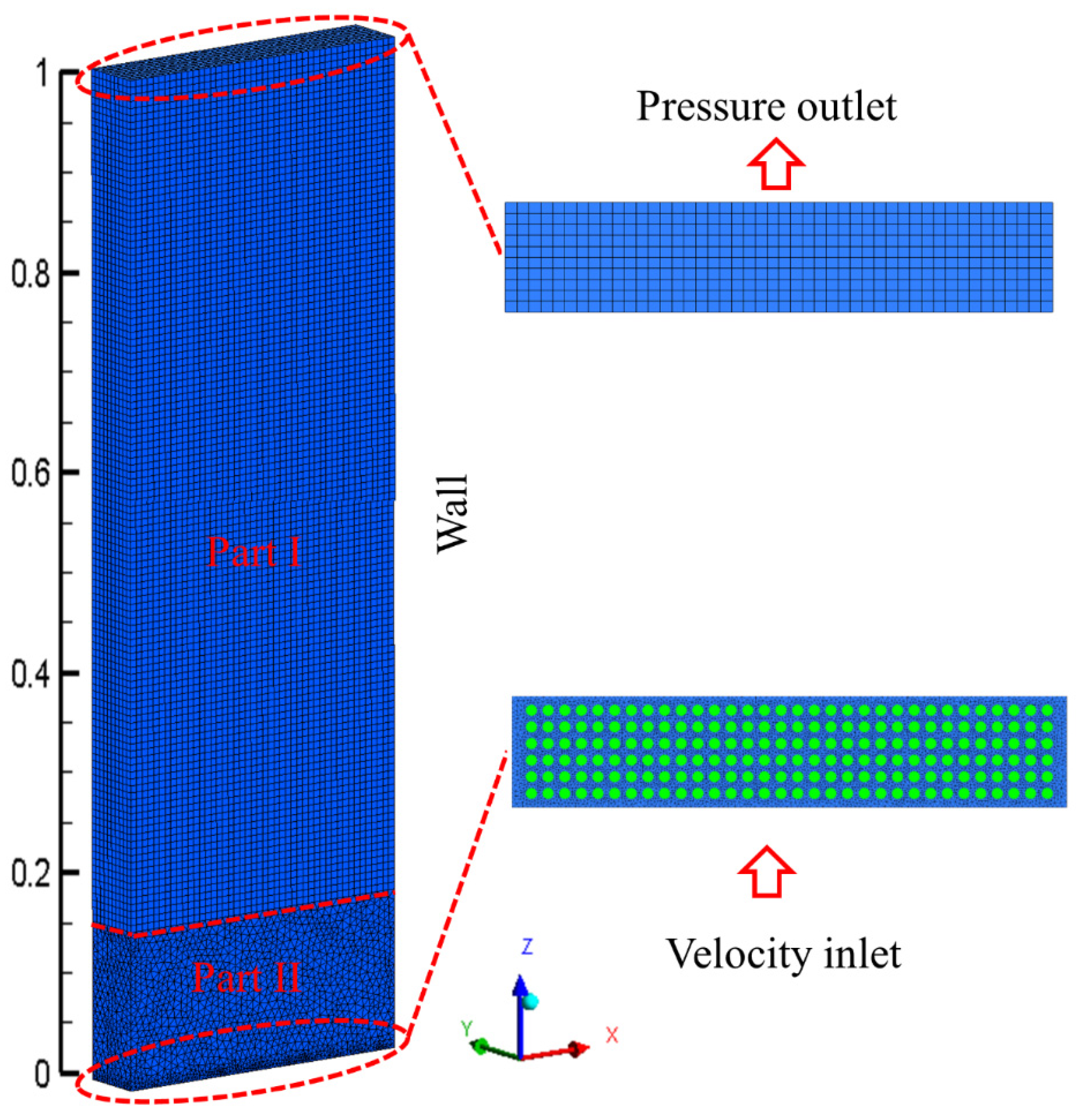
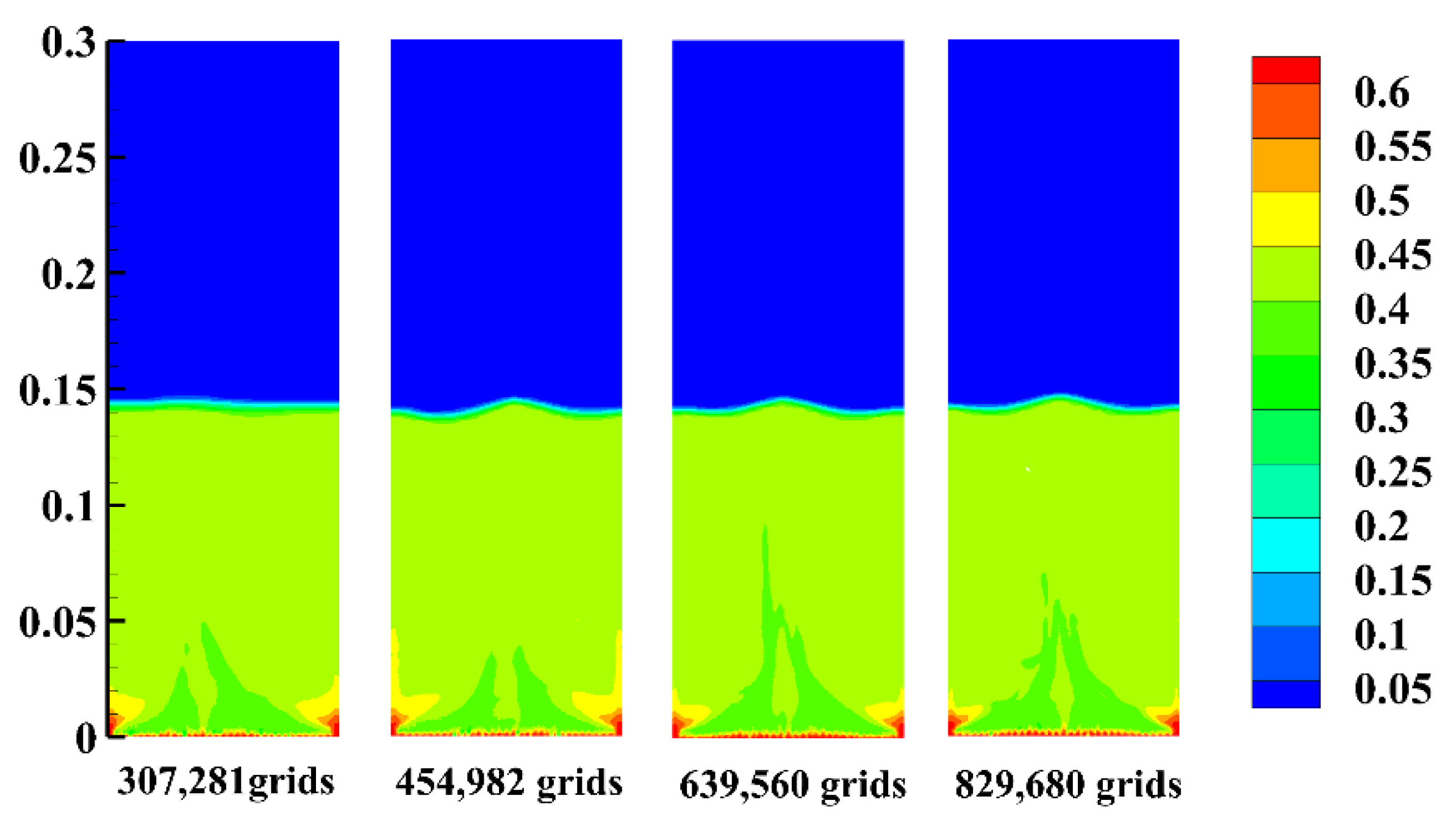
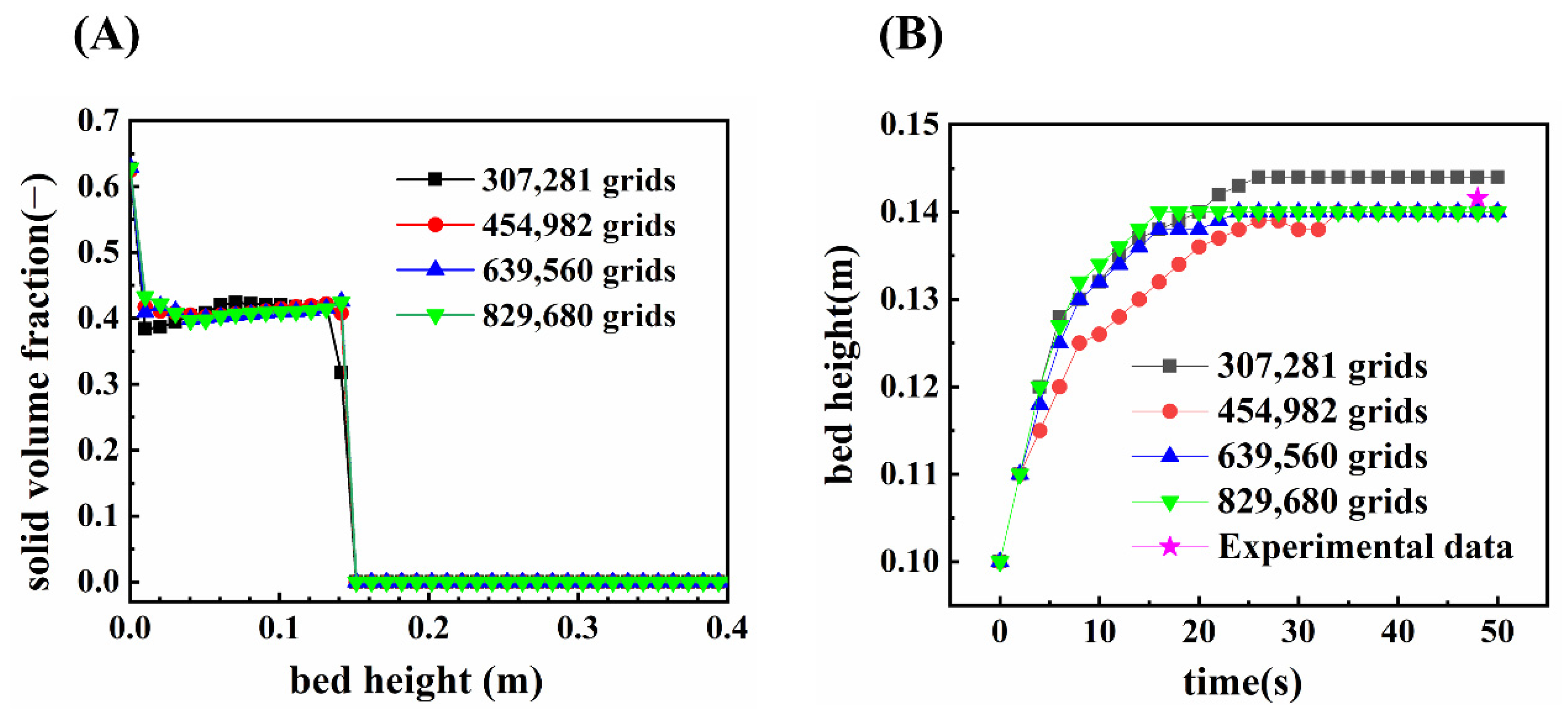
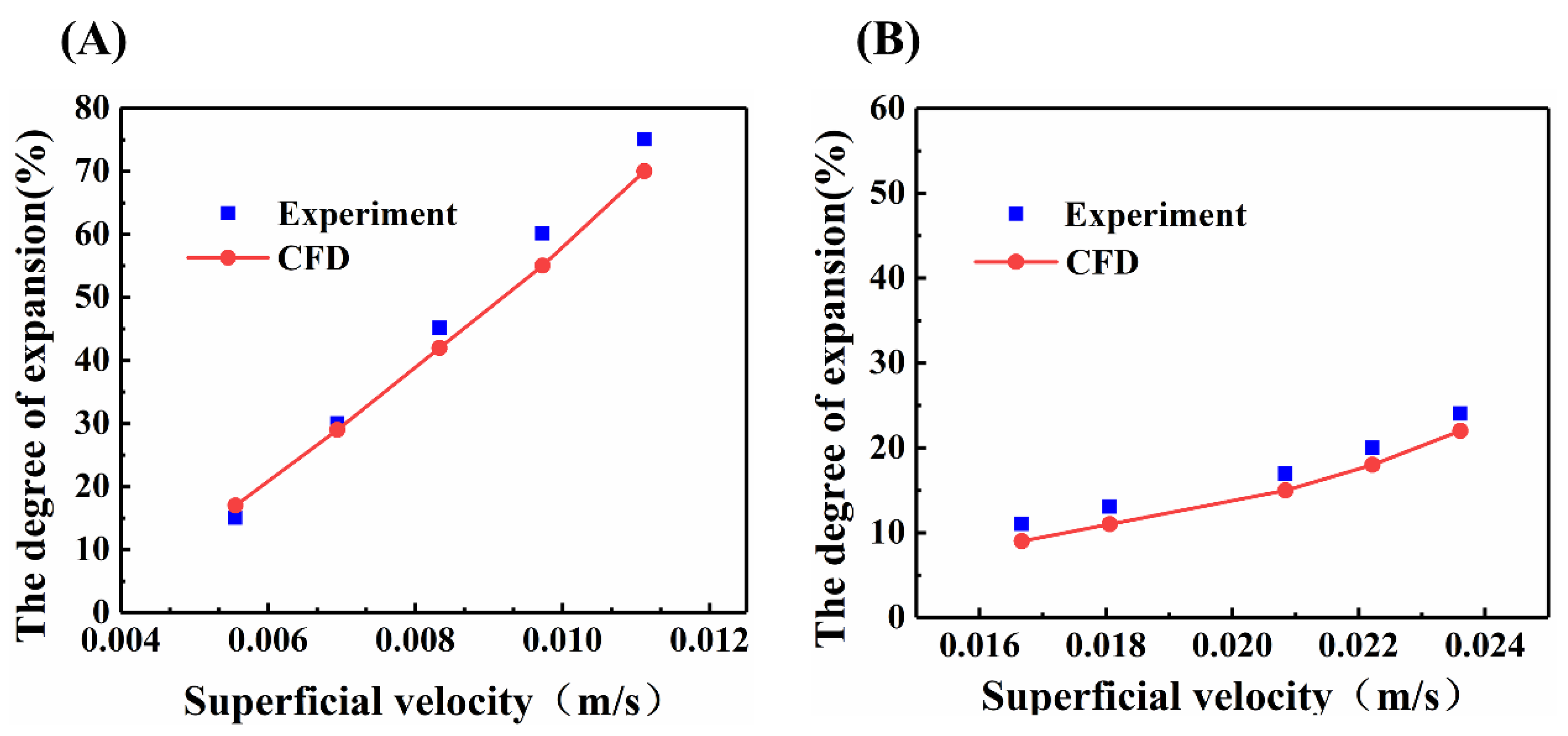
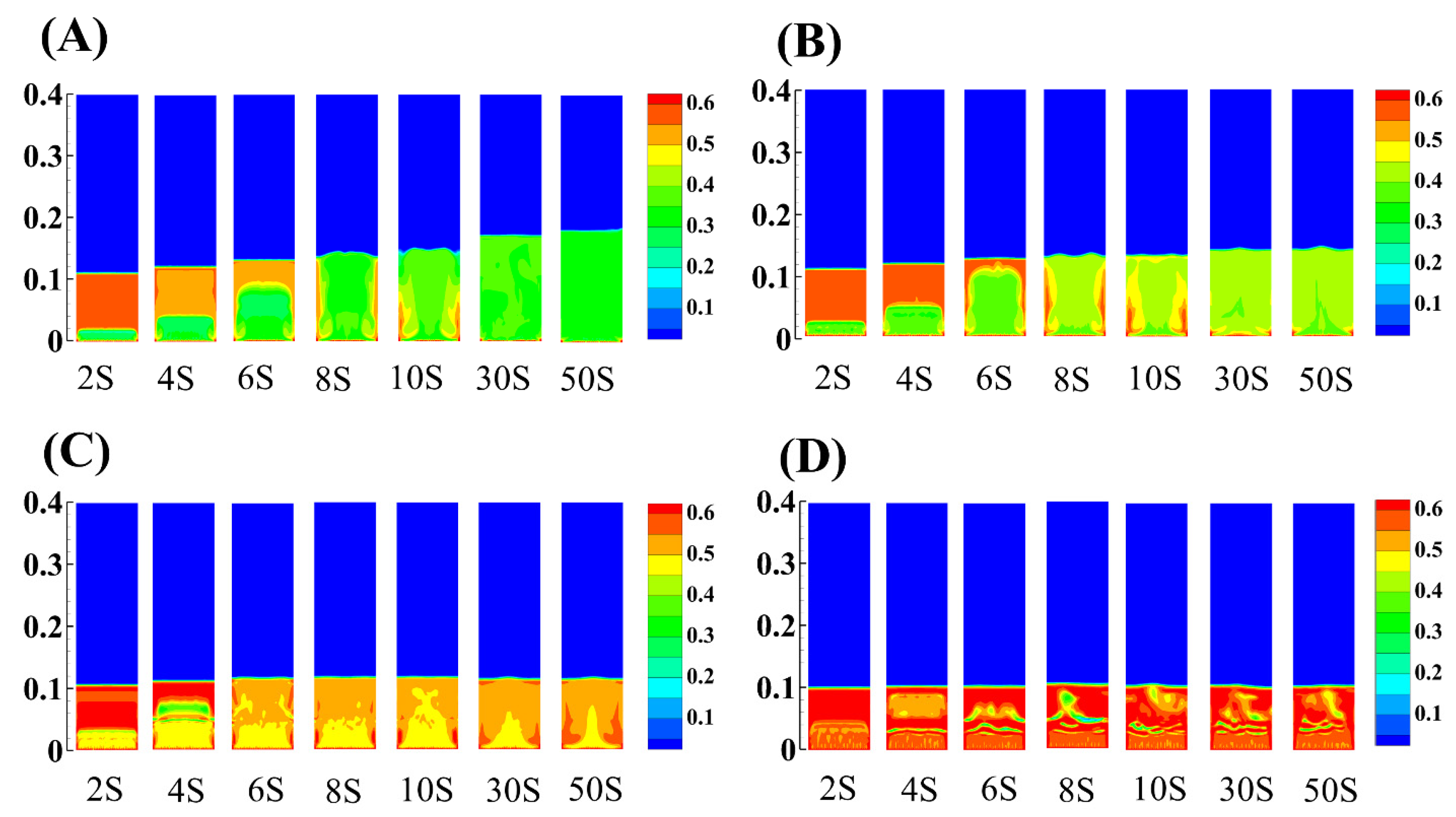
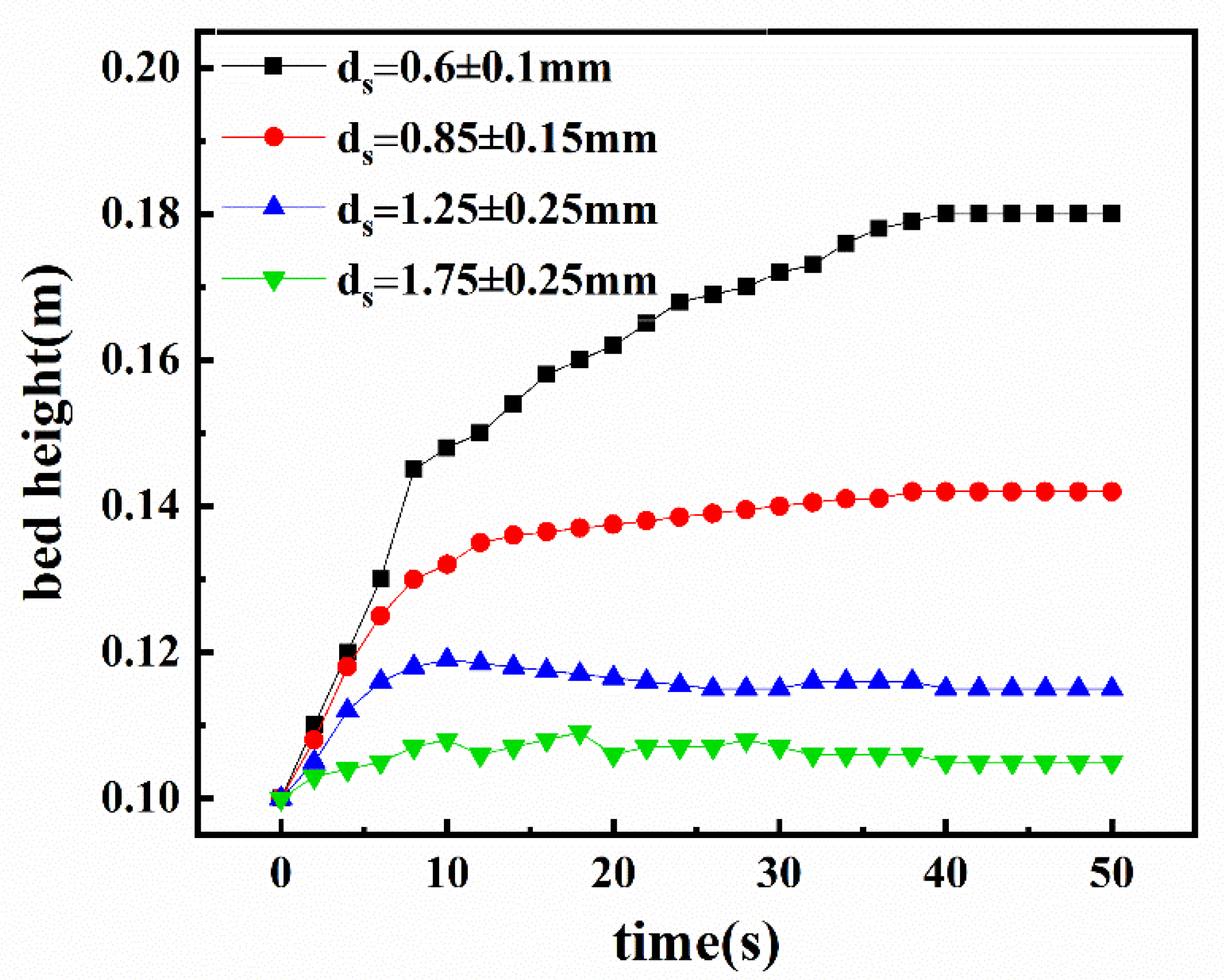
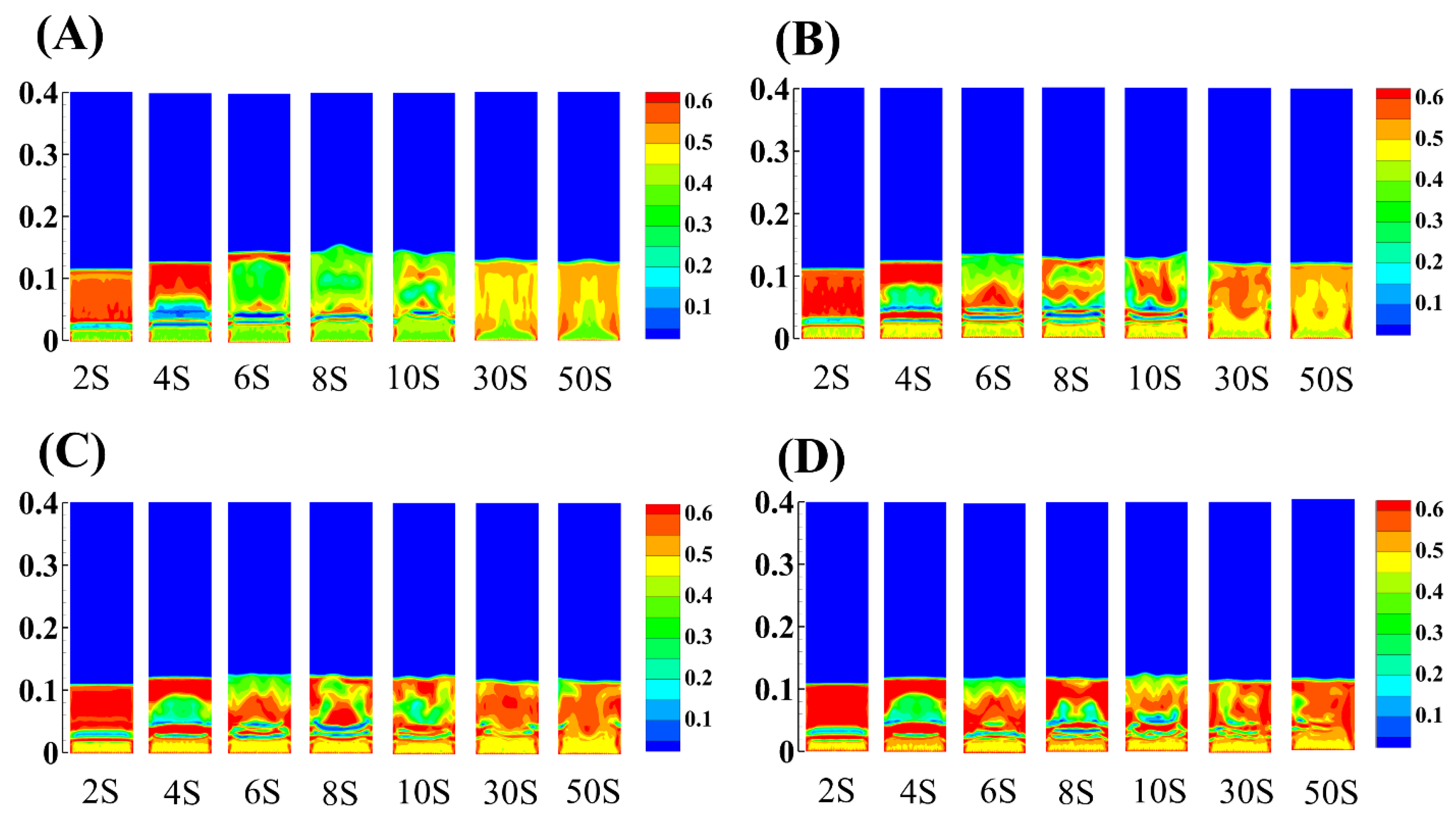

| Parameters | Liquid-Phase Density (kg/m3) | Liquid-Phase Viscosity (kg/(m·s)) | Particle Density (kg/m3) | Particle Diameter (mm) | Superficial Liquid Velocity (cm/s) | CFD Degree of Expansion (%) | Experimental Degree of Expansion (%) | Evaluation of Deviation (%) |
|---|---|---|---|---|---|---|---|---|
| 1 | 998.20 | 0.001003 | 1400–1500 | 0.6 ± 0.1 | 0.56 | 15.03 | 17.00 | 1.97 |
| 2 | 998.20 | 0.001003 | 1400–1500 | 0.6 ± 0.1 | 0.69 | 29.99 | 29.00 | 0.99 |
| 3 | 998.20 | 0.001003 | 1400–1500 | 0.6 ± 0.1 | 0.83 | 45.16 | 42.00 | 3.16 |
| 4 | 998.20 | 0.001003 | 1400–1500 | 0.6 ± 0.1 | 0.97 | 60.11 | 55.00 | 5.11 |
| 5 | 998.20 | 0.001003 | 1400–1500 | 0.6 ± 0.1 | 1.11 | 75.06 | 70.00 | 5.06 |
| 6 | 998.20 | 0.001003 | 1700–1800 | 1.75 ± 0.25 | 1.67 | 11.02 | 9.00 | 2.02 |
| 7 | 998.20 | 0.001003 | 1700–1800 | 1.75 ± 0.25 | 1.81 | 13.05 | 11.00 | 2.05 |
| 8 | 998.20 | 0.001003 | 1700–1800 | 1.75 ± 0.25 | 2.08 | 16.95 | 15.00 | 1.95 |
| 9 | 998.20 | 0.001003 | 1700–1800 | 1.75 ± 0.25 | 2.22 | 19.99 | 18.00 | 1.99 |
| 10 | 998.20 | 0.001003 | 1700–1800 | 1.75 ± 0.25 | 2.36 | 24.04 | 22.00 | 2.04 |
Publisher’s Note: MDPI stays neutral with regard to jurisdictional claims in published maps and institutional affiliations. |
© 2021 by the authors. Licensee MDPI, Basel, Switzerland. This article is an open access article distributed under the terms and conditions of the Creative Commons Attribution (CC BY) license (https://creativecommons.org/licenses/by/4.0/).
Share and Cite
Peng, J.; Sun, W.; Han, H.; Xie, L. CFD Modeling and Simulation of the Hydrodynamics Characteristics of Coarse Coal Particles in a 3D Liquid-Solid Fluidized Bed. Minerals 2021, 11, 569. https://doi.org/10.3390/min11060569
Peng J, Sun W, Han H, Xie L. CFD Modeling and Simulation of the Hydrodynamics Characteristics of Coarse Coal Particles in a 3D Liquid-Solid Fluidized Bed. Minerals. 2021; 11(6):569. https://doi.org/10.3390/min11060569
Chicago/Turabian StylePeng, Jian, Wei Sun, Haisheng Han, and Le Xie. 2021. "CFD Modeling and Simulation of the Hydrodynamics Characteristics of Coarse Coal Particles in a 3D Liquid-Solid Fluidized Bed" Minerals 11, no. 6: 569. https://doi.org/10.3390/min11060569
APA StylePeng, J., Sun, W., Han, H., & Xie, L. (2021). CFD Modeling and Simulation of the Hydrodynamics Characteristics of Coarse Coal Particles in a 3D Liquid-Solid Fluidized Bed. Minerals, 11(6), 569. https://doi.org/10.3390/min11060569





